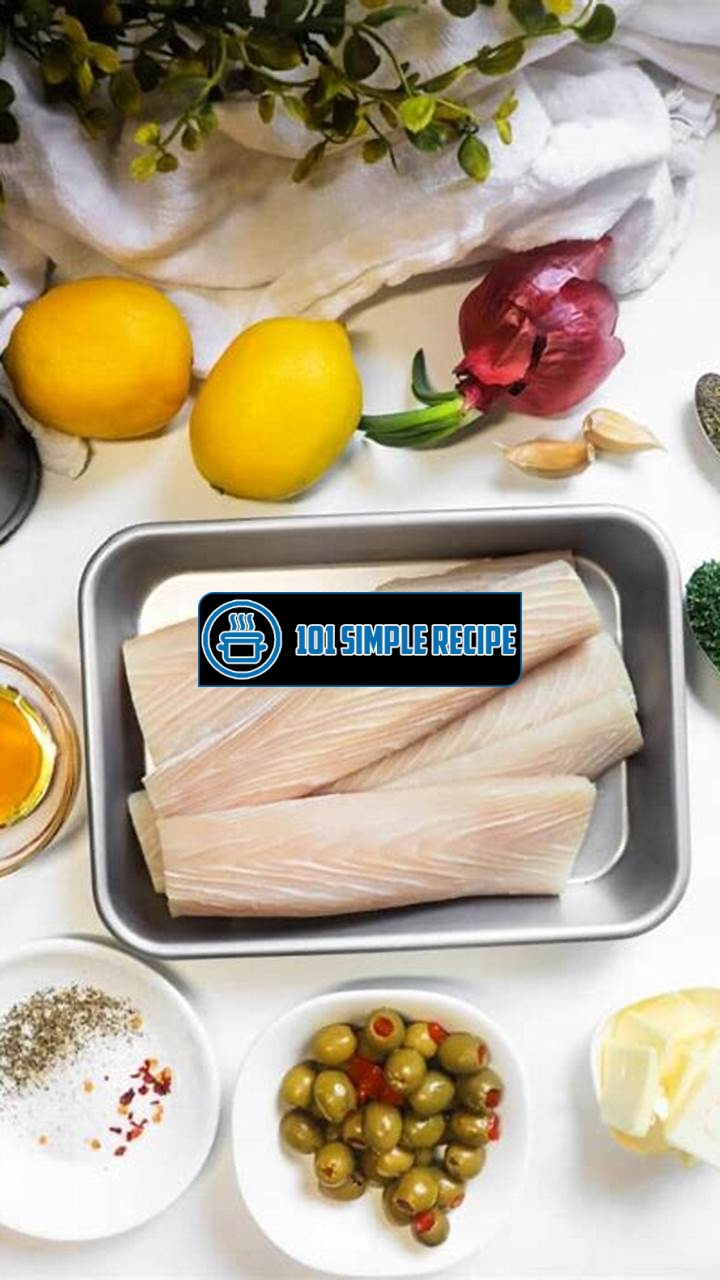Tired of serving the same old fish dishes week after week? Look no further! In this article, we will guide you through the process of baking mahi mahi to perfection, ensuring a flavorful and juicy meal every time. Whether you’re a seafood enthusiast or just looking to add some variety to your dinner menu, mastering the art of baking mahi mahi will undoubtedly impress your taste buds and leave you craving for more. So, put on your apron and let’s dive into the wonderful world of cooking this delectable fish! ️

The Basics of Baking Mahi Mahi
Discover the essential information you need to know about baking mahi mahi, including its cooking time and methods.
1. Understanding Mahi Mahi
Mahi mahi, also known as dolphinfish, is a popular fish that is prized for its firm texture and mild flavor. It is a versatile fish that can be grilled, sautéed, or baked. When baking mahi mahi, it’s important to understand the characteristics of the fish to ensure the best results.
Mahi mahi has a delicate flesh that can easily dry out if overcooked. It’s important to keep an eye on the cooking time and temperature to prevent the fish from becoming dry and tasteless.
Tip: Mahi mahi is a lean fish, so it can benefit from the addition of marinades or seasonings to enhance its flavor and moisture.
2. Preparing Mahi Mahi for Baking
Before baking mahi mahi, it’s important to properly prepare the fish to ensure even cooking and enhance the flavors. Here are the steps to prepare mahi mahi for baking:
- Start by rinsing the fish under cold water to remove any impurities.
- Pat the fish dry with paper towels to remove excess moisture.
- Tip: You can remove the skin of the mahi mahi if desired, but it can also be left on for added flavor and moisture.
- Season the fish with salt and pepper or your favorite seasonings. You can also choose to marinate the fish for added flavor.
3. Seasonings and Marinades for Mahi Mahi
Seasonings and marinades can greatly enhance the flavor of mahi mahi when baking. Here are a few popular options:
- Herbs and spices: Try seasoning mahi mahi with a blend of herbs and spices like garlic, paprika, and thyme for a flavorful kick.
- Citrus marinade: Marinating mahi mahi in a mixture of citrus juices like lemon, lime, and orange can give it a refreshing and tangy flavor.
- ️ Spicy marinade: If you prefer some heat, try marinating mahi mahi in a spicy blend of chili powder, cayenne pepper, and hot sauce.
4. Baking Mahi Mahi: Time and Temperature
When it comes to baking mahi mahi, getting the time and temperature right is key to achieving the perfect dish. Here are the general guidelines:
Note: The following temperatures are based on a preheated oven.
Thickness Temperature Cooking Time 1/2 inch 400°F (200°C) 6-8 minutes 1 inch 400°F (200°C) 10-12 minutes 1 1/2 inches 400°F (200°C) 12-15 minutes
Tip: The cooking time may vary depending on the thickness of the fish fillets. It’s important to check for doneness to ensure that the mahi mahi is cooked to perfection.
5. Checking for Doneness
To check if mahi mahi is cooked to perfection, you can use a fork to gently flake the fish. The fish should be opaque and easily flake apart when it’s done.
✅ Tip: It’s better to slightly undercook the mahi mahi than to overcook it. The residual heat will continue to cook the fish even after it’s taken out of the oven.
With these tips and guidelines, you now have the knowledge to bake mahi mahi to perfection. Whether you’re serving it as a main dish or using it in tacos or salads, your baked mahi mahi will surely impress!
For a tasty side dish, try making punch bowl recipe to complement your mahi mahi.
Understanding Mahi Mahi
Mahi Mahi, also known as Dolphinfish or Dorado, is a versatile fish that is popular among seafood lovers. It is widely considered a delicacy due to its mild flavor and firm, yet flaky texture. This fish can be prepared in various ways, including baking, grilling, or pan-searing. In this article, we will focus on baking Mahi Mahi to perfection. Before we dive into the details of baking, let’s explore the characteristics and nutritional benefits of this magnificent fish.
1. Mahi Mahi Flavor Profile
Mahi Mahi has a mild and sweet flavor with a hint of nuttiness. Its flesh is lean and succulent, making it an excellent choice for those who prefer milder-tasting seafood. When baked, the flavors are enhanced, and the fish becomes moist and tender. The natural sweetness of Mahi Mahi pairs well with a variety of seasonings and marinades, allowing you to experiment with different flavor profiles. Whether you prefer a zesty citrus marinade or a herb-infused seasoning, Mahi Mahi will readily absorb the flavors, creating a delicious culinary experience.
2. Mahi Mahi Nutritional Value
When it comes to nutrition, Mahi Mahi is a powerhouse of essential nutrients. It is low in calories and contains high levels of protein, making it an ideal choice for a healthy and balanced diet. Additionally, Mahi Mahi is rich in omega-3 fatty acids, which are known for their numerous health benefits. These fatty acids help reduce inflammation, improve heart health, and support brain function. Moreover, Mahi Mahi is a good source of vitamins and minerals, including vitamin B12, selenium, and potassium. Eating Mahi Mahi regularly can contribute to maintaining overall health and wellbeing.
Fun fact: Did you know that a 3-ounce serving of Mahi Mahi provides around 20 grams of protein and only 100 calories?
3. Sourcing Sustainable Mahi Mahi
As consumers, it is essential to be conscious of the origin and sustainability of the seafood we consume. Mahi Mahi is a fish that is typically abundant and has a relatively low environmental impact when caught using sustainable fishing practices. To ensure you are purchasing sustainable Mahi Mahi, look for labels or certifications from reputable seafood organizations, such as the Marine Stewardship Council (MSC). These certifications ensure that the fish you are buying is sourced responsibly and has been harvested using methods that minimize the impact on the marine ecosystem. By choosing sustainably sourced Mahi Mahi, you can enjoy this delicious fish while supporting the preservation of ocean biodiversity.
In conclusion, Mahi Mahi is a versatile fish that offers a delightful dining experience. Its mild flavor, nutritional value, and sustainability make it an excellent choice for seafood enthusiasts. Now that you have a better understanding of Mahi Mahi, let’s move on to the exciting part – baking this delicious fish to perfection!
Preparing Mahi Mahi for Baking
Discover the steps involved in properly preparing mahi mahi before it goes into the oven.
1. Thawing Frozen Mahi Mahi
Thawing frozen mahi mahi is the first step toward baking it to perfection. Take the frozen fillets out of their packaging and place them on a plate or tray. It is essential to thaw the fish properly to ensure even cooking throughout. To thaw, you have two options:
- Refrigerator thawing: This is the recommended method as it allows for safe, gradual thawing. Place the frozen mahi mahi in a covered container and let it thaw in the refrigerator. This process may take anywhere from 12 to 24 hours, depending on the size and thickness of the fillets.
- Cold water thawing: If you need to thaw the fish quickly, you can use the cold water method. Ensure the fish is in a leak-proof plastic bag, then submerge it in cold water. Change the water every 30 minutes to maintain a cold temperature. The fish should be thawed within 1 to 2 hours using this method.
2. Removing Scales and Skin
Before baking, it’s important to remove the scales and skin from the mahi mahi fillets. Start by rinsing the fillets under cold water to remove any loose scales. Use a fish scaler or a knife to gently scrape the scales off, working from the tail towards the head.
Next, remove the skin by placing the fillet skin-side down on a clean cutting board. Holding the tail end firmly, slide a sharp knife between the skin and the flesh at a slight angle. Use a back-and-forth motion, guiding the knife along the length of the fillet, separating the flesh from the skin.
3. Deboning Mahi Mahi
Deboning the mahi mahi fillets ensures a bone-free eating experience. While many fish fillets have small pin bones, mahi mahi does not typically have them. However, it’s always good to double-check before baking.
To debone the fillets, run your fingers gently over the flesh to feel for any stray bones. If you come across any, use a pair of clean tweezers or fish bone pliers to carefully remove them. Take your time and work slowly to avoid damaging the delicate flesh.
Once you have finished deboning the mahi mahi fillets, they are ready to be baked to perfection! Follow your favorite mahi mahi recipe for baking time and temperature, and enjoy a delicious and bone-free meal. ️
weight loss recipe can be a healthy addition to your mahi mahi dish.
Seasonings and Marinades for Mahi Mahi
When it comes to baking mahi mahi, the right seasonings and marinades can make all the difference. Not only do they enhance the natural flavors of this delicious fish, but they also add a depth of taste that will have your taste buds dancing with delight. Whether you prefer a simple lemon and herb seasoning, a spicy Cajun rub, or a tropical fruit salsa marinade, there are endless options to explore and experiment with. So, let’s dive right in and discover how to take your baked mahi mahi to the next level.
1. Simple Lemon and Herb Seasoning
If you’re looking for a classic and refreshing flavor profile, a simple lemon and herb seasoning is the way to go. Start by squeezing fresh lemon juice all over your mahi mahi fillets, allowing the citrusy goodness to seep into every crevice. Then, generously sprinkle a mixture of chopped fresh herbs such as parsley, basil, and thyme onto the fish. The aroma of the herbs will blend beautifully with the tangy lemon, creating a delightful symphony of flavors.
2. Spicy Cajun Rub
If you prefer a little kick of heat, a spicy Cajun rub will add a fiery burst of flavor to your mahi mahi. Create your own Cajun spice blend by combining ingredients such as paprika, cayenne pepper, garlic powder, and onion powder. Rub this spicy concoction onto the fish, making sure to coat it evenly. Allow the mahi mahi to marinate for at least 30 minutes to let the flavors penetrate the flesh. Once baked, you’ll be treated to a deliciously spicy mahi mahi that will have your taste buds tingling with excitement.
3. Tropical Fruit Salsa Marinade
For a taste of the tropics, try marinating your mahi mahi in a vibrant tropical fruit salsa. Combine diced pineapple, mango, red bell pepper, red onion, cilantro, and lime juice to create a refreshing and zesty salsa. This fruity marinade will infuse your fish with a burst of tropical flavors, transporting you to a sunny beach paradise with every bite. ️
4. Zesty Garlic and Ginger Glaze
If you’re ready to take your baked mahi mahi to a whole new level of deliciousness, try a zesty garlic and ginger glaze. Create a marinade by mixing minced garlic, grated ginger, soy sauce, honey, and a squeeze of fresh lime juice. The combination of the garlic and ginger adds a bold and aromatic flavor to the fish, while the sweet and tangy glaze caramelizes beautifully when baked. This tantalizing blend of flavors will leave your taste buds begging for more.
Now that you have four tantalizing options to choose from, it’s time to gather your ingredients, preheat your oven, and get ready to bake mahi mahi to perfection. Whichever seasoning or marinade you decide to use, one thing is for sure – your taste buds are in for a treat with these flavorful creations. So, go ahead and explore the wide world of seasonings and marinades to create a culinary masterpiece that will impress everyone at your table. Happy cooking! ️
white castle recipe is a great option if you’re looking for something unique to bake alongside your mahi mahi.
Baking Mahi Mahi: Time and Temperature
In order to achieve perfectly baked mahi mahi, it is important to pay attention to the time and temperature settings. By understanding the ideal oven temperature and cooking time guidelines, you can ensure that your mahi mahi turns out delicious every time. Additionally, there are certain factors that can affect the cooking time of mahi mahi, which we will explore in this article.
1. Oven Temperature for Baking Mahi Mahi
The oven temperature plays a crucial role in baking mahi mahi to perfection. It is recommended to preheat the oven to 400 degrees Fahrenheit (200 degrees Celsius) for optimal results. This temperature allows the fish to cook evenly and develop a nicely browned exterior while maintaining a moist and flaky interior.
Note: Preheating the oven is essential to ensure that the mahi mahi cooks properly and evenly throughout.
2. Cooking Time Guidelines
The cooking time for mahi mahi can vary depending on several factors. As a general guideline, it is recommended to bake mahi mahi at 400 degrees Fahrenheit (200 degrees Celsius) for approximately 15-20 minutes. However, the exact cooking time may differ based on the thickness of the fish fillets or steaks.
If the fillets or steaks are thinner, they will require less time to cook, typically around 10-15 minutes. On the other hand, thicker cuts of mahi mahi may take slightly longer, ranging from 20-25 minutes. It is important to keep a close eye on the fish while it is baking to prevent overcooking.
Note: Cooking time can vary, so it is recommended to use a food thermometer to check for an internal temperature of 145 degrees Fahrenheit (63 degrees Celsius) to ensure that the mahi mahi is fully cooked.
3. Factors Affecting Cooking Time
Several factors can influence the cooking time of mahi mahi. The thickness of the fillets or steaks is one of the primary factors. Thicker cuts will require more time in the oven, while thinner cuts will cook faster.
Another factor to consider is the starting temperature of the fish. If the mahi mahi is chilled or at room temperature before baking, it will require less time to cook. On the other hand, if the fish is frozen, it will need additional time to reach the desired level of doneness.
Additionally, the type of oven used can affect the cooking time. Different ovens may have variations in heat distribution, which can impact the overall baking time. It is recommended to familiarize yourself with your specific oven’s performance and make necessary adjustments if needed.
To summarize:
- Preheat the oven to 400 degrees Fahrenheit (200 degrees Celsius) for optimal results.
- Bake mahi mahi for approximately 15-20 minutes, adjusting the time based on the thickness of the fillets or steaks.
- Use a food thermometer to ensure that the fish reaches an internal temperature of 145 degrees Fahrenheit (63 degrees Celsius).
- Consider factors such as the starting temperature and oven performance when determining the cooking time.
By following these guidelines and taking into account the various factors that can affect the cooking time, you can bake mahi mahi to perfection, achieving a flavorful and tender dish every time. Enjoy!
Checking for Doneness
Discover the methods to ensure your mahi mahi is cooked to perfection.
1. Using a Meat Thermometer
To determine how long to bake mahi mahi, one effective method is to use a meat thermometer. This tool allows you to measure the internal temperature of the fish, ensuring it reaches the optimal level for doneness. The general guideline for mahi mahi is to bake it until it reaches an internal temperature of 145°F (63°C).
When using a meat thermometer, insert it into the thickest part of the fish, away from any bones. Make sure the probe is not touching the pan or the bone, as this can give inaccurate readings. Once the temperature reaches 145°F (63°C), your mahi mahi is ready to be taken out of the oven.
Note: ️ Make sure to clean your meat thermometer before and after each use to prevent cross-contamination.
2. Visual Indicators of Doneness
If you don’t have a meat thermometer on hand, you can rely on visual indicators to check if your mahi mahi is cooked to perfection. Here are some signs to look out for:
- The flesh should be opaque and have a whitish color throughout. Translucency is an indication that the fish is still undercooked.
- The fish should easily flake apart when tested with a fork. If it is still firm and resists flaking, it needs more time in the oven.
- The edges of the mahi mahi should be slightly crispy and golden brown, adding a delicious texture to the fish.
Note: It’s always better to slightly undercook the fish than to overcook it, as you can always return it to the oven if needed. Overcooked mahi mahi can turn dry and lose its delicate texture.
3. Testing Flakeiness
If you’re unsure about the doneness of your mahi mahi, another useful test is to check for flakeiness. Take a fork and gently press it into the thickest part of the fish, then twist the fork slightly. The fish should flake apart easily and appear moist, indicating that it is fully cooked.
Keep in mind that the texture of mahi mahi should be slightly firm and juicy when cooked properly. If it feels mushy or excessively soft, it may be a sign of overcooking.
Note: ❗ Remember to handle the fish with care when performing the flakeiness test to avoid breaking it apart too much.
By employing these methods, you can ensure that your mahi mahi is perfectly cooked every time. Whether you choose to use a meat thermometer or rely on visual indicators and flakeiness, following these techniques will result in a delicious and tender mahi mahi dish.
Thank you for reading this article on how long to bake mahi mahi. We hope you found the information helpful and that it inspires you to try this delicious fish recipe in your own kitchen. Remember, cooking is all about experimenting and adding your own personal touch! If you have any other questions or need further assistance, feel free to visit our website again for more cooking tips and recipes. Happy cooking!
Frequently Asked Questions
Here are some frequently asked questions about baking mahi mahi:
| No. | Questions | Answers |
|---|---|---|
| 1. | How long should I bake mahi mahi? | The recommended baking time for mahi mahi is 12-15 minutes at 400°F (200°C) or until the fish is opaque and flakes easily with a fork. |
| 2. | What temperature should the oven be set to? | Preheat your oven to 400°F (200°C) before placing the mahi mahi in for baking. |
| 3. | Should I use parchment paper or aluminum foil? | Either parchment paper or aluminum foil can be used to line the baking dish. This helps prevent the fish from sticking and makes cleanup easier. |
| 4. | Can I marinate the mahi mahi before baking? | Yes, marinating the mahi mahi before baking can add extra flavor. You can use your favorite marinade or try a simple combination of olive oil, lemon juice, garlic, salt, and pepper. |
| 5. | How do I know if the mahi mahi is done baking? | The mahi mahi is done baking when it is opaque and flakes easily with a fork. You can also use a meat thermometer to ensure the internal temperature reaches 145°F (63°C). |
| 6. | What are some serving suggestions for baked mahi mahi? | Baked mahi mahi pairs well with a variety of side dishes such as steamed vegetables, quinoa, rice, or a fresh salad. You can also drizzle it with a lemon-butter sauce for added flavor. |
Closing Thoughts
We hope you feel confident in baking mahi mahi after reading this article. Remember, the key is to ensure the fish is cooked through but still moist and flavorful. Experiment with different seasonings and sides to create a dish that suits your taste buds. Don’t be afraid to try new recipes and techniques in the kitchen, and don’t forget to enjoy the process and the delicious results. Thank you once again for reading, and we look forward to your next visit!
Jump to Recipe
Baked Mahi Mahi

Learn how to bake mahi mahi to perfection with this easy recipe.
- 4 mahi mahi fillets
- 2 tablespoons olive oil
- 1 lemon (juiced)
- 2 cloves garlic (minced)
- Salt and pepper to taste
- Preheat your oven to 400°F (200°C).
- In a small bowl, whisk together the olive oil, lemon juice, minced garlic, salt, and pepper.
- Place the mahi mahi fillets in a baking dish and pour the marinade over them. Make sure each fillet is well coated.
- Bake the mahi mahi for 12-15 minutes, or until it is opaque and flakes easily with a fork.
- Remove the fish from the oven and let it rest for a few minutes. Serve with your favorite side dishes and enjoy!






